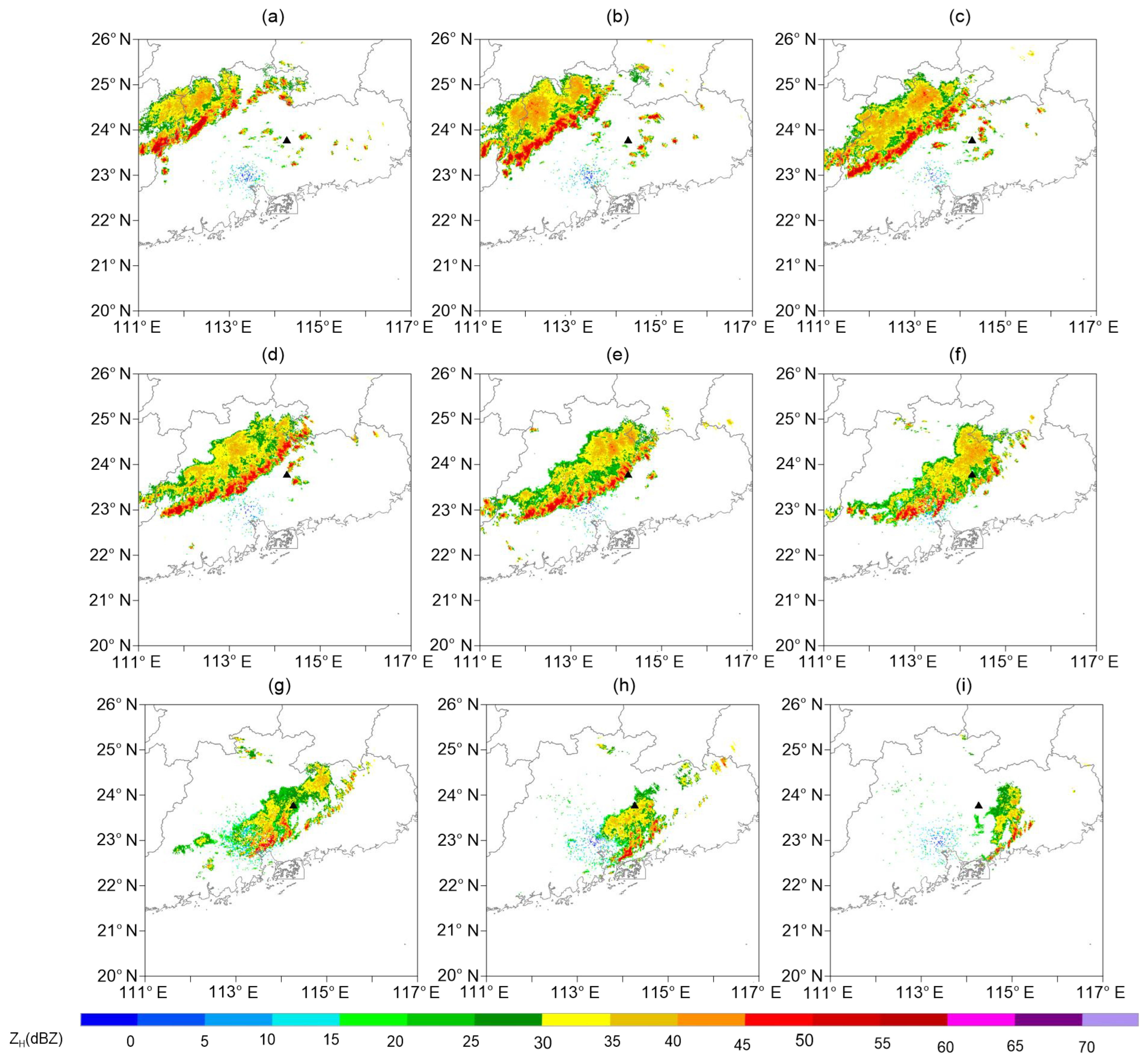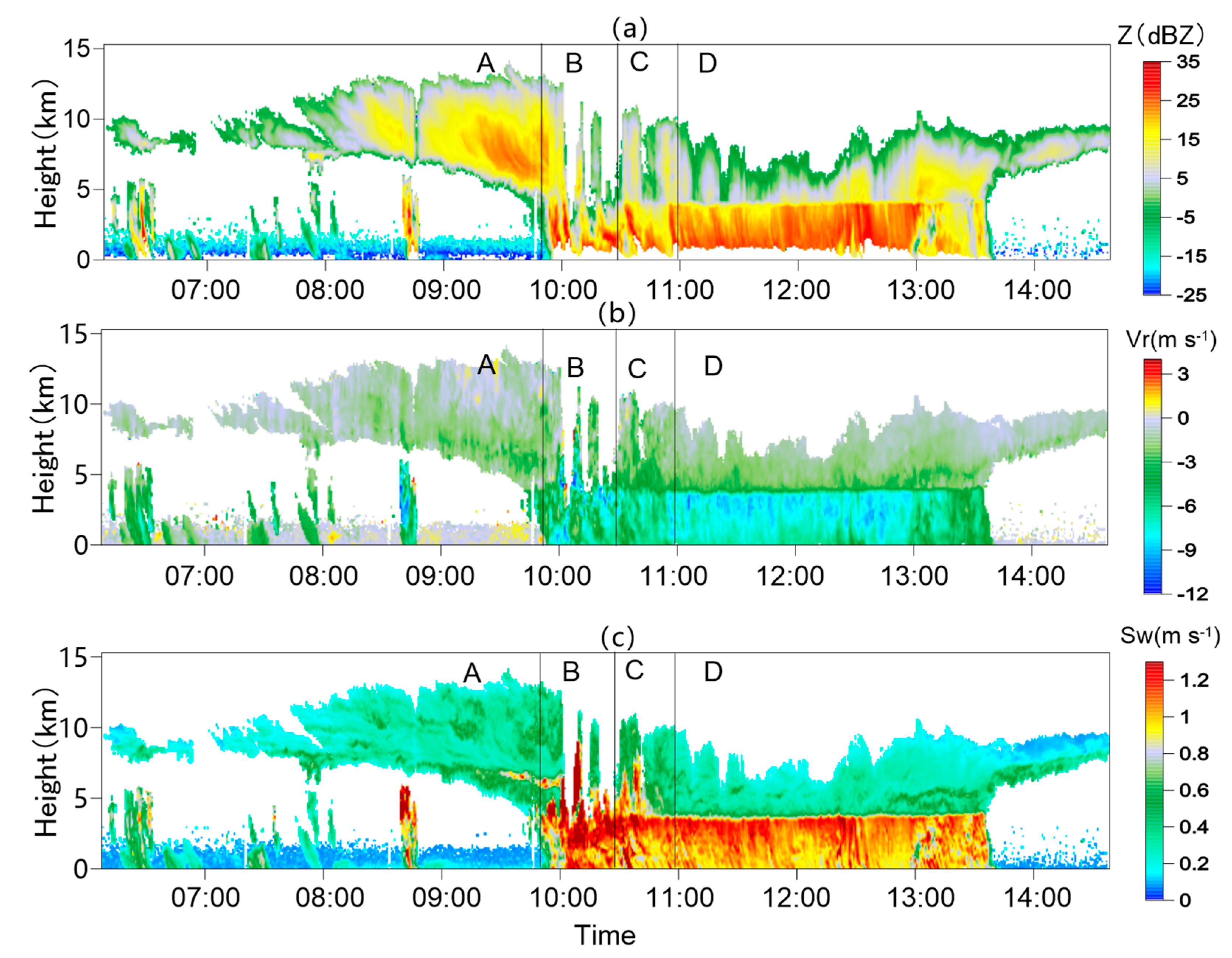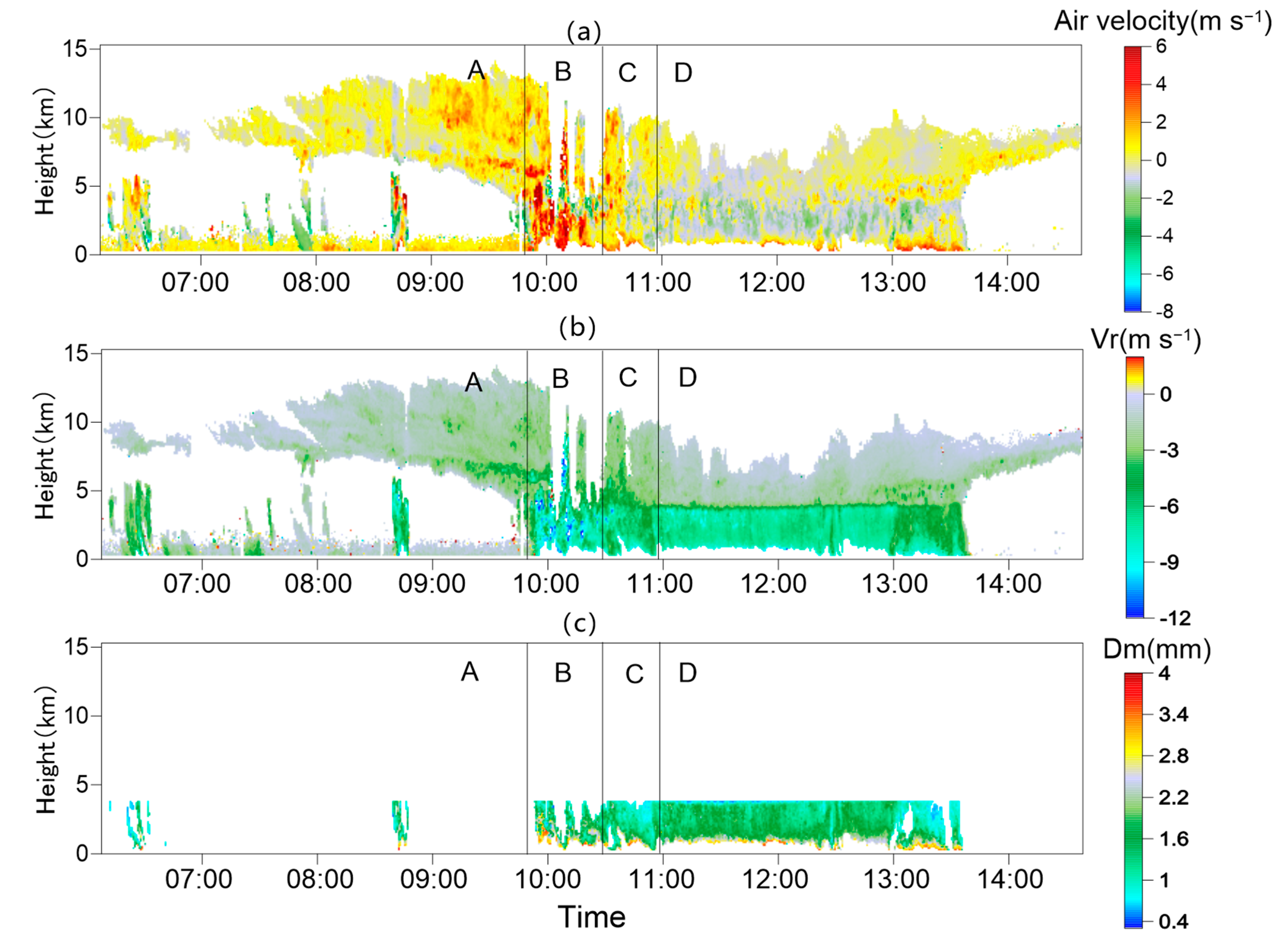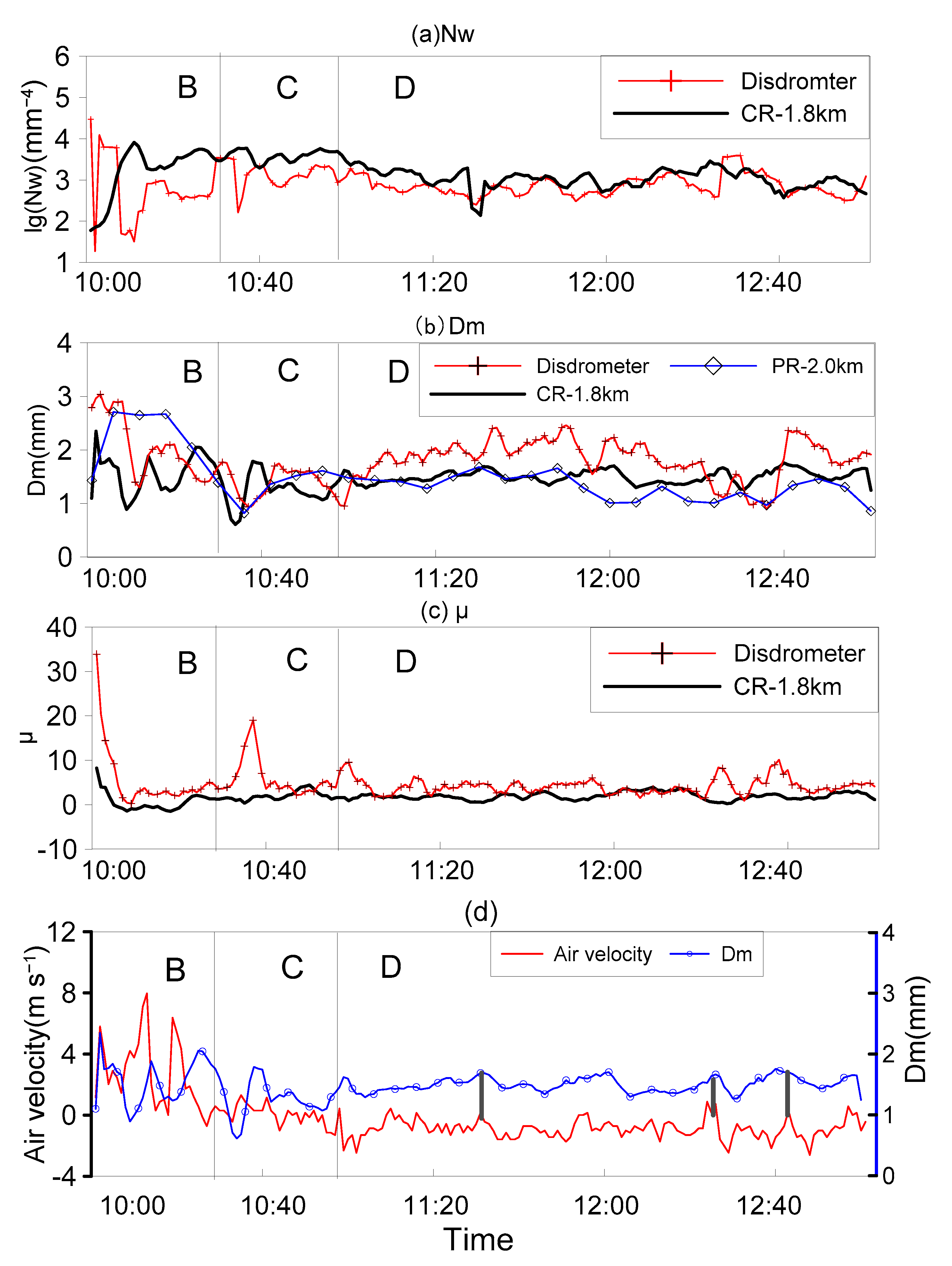Analysis of the Vertical Air Motions and Raindrop Size Distribution Retrievals of a Squall Line Based on Cloud Radar Doppler Spectral Density Data
Abstract
:1. Introduction
2. Instruments
3. Data Quality Control and Retrieval Methods
3.1. Data Quality Control
3.2. Vertical Air Velocity Retrieval
3.3. Raindrop Size Distribution Retrieval
3.4. DSD Fitting
4. Detection
Detecting of a Squall Line by CR and PR
5. Retrieval Results
5.1. Vertical Air Velocity
5.2. DSD
5.2.1. Comparison with Disdrometer
5.2.2. Comparison of Vertical Profiles
6. Conclusions
- (1)
- CR and PR detected cloud structures as the squall line passed, showing the evolution of the stages before passage (segment A), the strong convection time segment (segment B), the transition time segment (segment C), and the stratiform cloud time segment (segment D). The detection results showed that some local convection with falling rain inside and an upper layer altostratus cloud existed in segment A. The altostratus cloud was the blanket cloud extending from the front end of the squall line body. When the main body of the squall line passed by in segment B, strong convection and precipitation existed, with a reflectivity factor exceeding 35 dBZ and a velocity spectrum width exceeding 1.3 m s−1 detected by CR. As a result, intensive attenuation was caused by the heavy rain in the CR detection; thus, part of the echo in the upper layer could not be observed. According to the PR polarization parameters, Z of segment B was very high, with a maximum of 50 dBZ, and Zdr was 1–2, with the Kdp large value also representing large liquid water content. In segments C and D, the cloud and rain stabilized gradually, with descending cloud tops, stable precipitation, and a zero-layer bright band. Smaller Kdp values (less than 0.9) were distributed in the 0 °C layer, at approximately 3–5 km, which may have been caused by the melting of ice crystal particles. The strong attenuation is a limitation in the use of millimeter-wavelength radar.
- (2)
- In the CR-retrieved vertical air velocity within the squall line in segment A, the downdraft was dominant in the local convection and a weak updraft existed in the higher-altitude altostratus clouds. In segment B, the strong upward speed under 5 km was significant, reaching more than 8 m s−1. Between segments C and D, the upward air velocity changed gradually to a wide range of weak downdrafts.
- (3)
- We calculated the CR data for DSD evolution during the passage of the squall line. Dm was almost entirely distributed within 1–2 mm at all heights. First, in the comparison of DSD by CR at 1.5 km and DSD data obtained on the ground, the retrieved DSD line was lower than the disdrometer in segment C, and the difference decreased between segments C and D. Second, DSDs were fitted using a normalized gamma distribution. In segments C and D, the Nw and μ values of the CR-retrieved DSD at 1.8 km showed good agreement with the ground data. The CR-retrieved Dm at 1.8 km was very close to the PR-retrieved Dm at 2 km; however, the Dm of the ground DSD was generally larger than both. Therefore, comparing with the DSD retrieved at around 2 km, the overall number concentration remained unchanged and Dm got larger on the ground, possibly reflecting the process of raindrop coalescence. Third, in segment B, CR-retrieved DSD parameters fluctuated greatly, but failed to reflect the characteristics of large raindrops, as shown by the disdrometer DSD parameters. Echo attenuation may have a significant influence on results retrieved in segment B.
- (4)
- In the comparison of the average vertical profiles of several quantities in segments B, C, and D, first, the CR-retrieved Dm decreased with height. The decrease of Nw and Dm with height in segments C and D were similar, which reflects the collision effect of falling raindrops. The changes were opposite in segment B, with Nw decreasing and Dm increasing as the height decreased. This indicates that raindrops underwent intense mixing and rapid collision and growth. Second, in segments B and C, the CR-retrieved Dm was approximately 0.5 mm smaller than the PR-retrieved Dm, and the distribution trends of the overlapping height range were similar. This is partly because of the Z difference of the two radars caused by the serious echo attenuation of CR. In segment D, the Dm values of the two radars within 2–4 km were consistent. Overall, the PR-retrieved Dm can verify the veracity of the CR-retrieved Dm. Third, from the mean vertical velocity profile of different segments, the larger rising velocity in the CR retrieval corresponded to the larger Dm, especially in segment C and D. The vertical velocity profile peak generated a larger Dm value.
Author Contributions
Funding
Institutional Review Board Statement
Informed Consent Statement
Acknowledgments
Conflicts of Interest
References
- Houze, R.A.; Biggerstaff, M.I.; Rutledge, S.A.; Smull, B.F. Interpretation of Doppler weather radar displays of midlatitude mesoscale convective systems. Bull. Am. Meteorol. Soc. 1989, 70, 608–619. [Google Scholar] [CrossRef] [Green Version]
- Houze, R.A.; Smull, B.F.; Dodge, P. Mesoscale organization of springtime rainstorms in Oklahoma. Mon. Weather Rev. 1990, 118, 613–654. [Google Scholar] [CrossRef]
- Chong, M.; Amayenc, P.; Scialom, G.; Testud, J. A tropical squall line observed during the COPT 81 Experiment in west Africa. Part Ⅰ: Kinematic structure inferred from dual-Doppler radar data. Mon. Weather Rev. 1987, 115, 670–694. [Google Scholar] [CrossRef] [Green Version]
- Frankhuaser, J.C.; Barnes, G.M.; LeMone, M.A. Structure of a midlatitude squall line formed in strong unidirectional shear. Mon. Weather Rev. 1992, 120, 237–260. [Google Scholar] [CrossRef]
- Wang, T.C.C.; Lin, Y.K.; Shen, H.; Pasken, R.W. Characteristics of a subtropical squall line determined from TAMEX dual-Doppler data. Part Ⅰ: Kinematic structure. J. Atmos. Sci. 1990, 47, 2357–2381. [Google Scholar] [CrossRef] [Green Version]
- Roux, F. Retrieval of thermodynamic fields from multiple-Doppler radar data using the equations of motion and the thermodynamic equation. Mon. Weather Rev. 1985, 113, 2142–2157. [Google Scholar] [CrossRef] [Green Version]
- Pan, Y.J.; Zhao, K.; Pan, Y.N.; Wang, Y.P. Dual-Doppler analysis of a squall line in southern China. Acta Meteorol. Sin. 2012, 70, 736–751. [Google Scholar] [CrossRef]
- Wu, H.Y.; Chen, H.S.; Jiang, Y.F. Observation and Simulation Analyses on Dynamical Structure Features in a Severe Squall Line Process on 3 June 2009. Plateau Meteorol. 2012, 32, 1084–1094. (In Chinese) [Google Scholar] [CrossRef]
- Kollias, P.; Albrecht, B.A.; Marks, F. Why Mie? Accurate Observations of Vertical Air Velocities and Raindrops Using a Cloud Radar. Bull. Am. Meteorol. Soc. 2002, 83, 1471–1483. [Google Scholar] [CrossRef] [Green Version]
- Shupe, M.D.; Kollias, P.; Poellot, M.; Eloranta, E. On Deriving Vertical Air Motions from Cloud Radar Doppler Spectra. J. Atmos. Ocean. Technol. 2008, 25, 547. [Google Scholar] [CrossRef] [Green Version]
- Tridon, F.; Planche, C.; Mroz, K.; Banson, S.; Battaglia, A.; Baelen, J.V.; Wobrock, W. On the Realism of the Rain Microphysics Representation of a Squall Line in the WRF Model. Part I: Evaluation with Multifrequency Cloud Radar Doppler Spectra Observations. Mon. Weather Rev. 2019, 147, 2787–2810. [Google Scholar] [CrossRef] [Green Version]
- Liu, L.P.; Xie, L.; Cui, Z.H. Examination and application of Doppler spectral density data in drop size distribution retrieval in weak precipitation by cloud radar. Chin. J. Atmos. Sci. 2014, 38, 223–236. (In Chinese) [Google Scholar] [CrossRef]
- Peng, L.; Chen, H.B.; Li, B. A case study of deriving vertical air velocity from 3-mm cloud radar. Chin. J. Atmos. Sci. 2012, 36, 1–10. (In Chinese) [Google Scholar] [CrossRef]
- Hildebrand, P.H.; Sekhon, R.S. Objective determination of the Noise Level in Doppler Spectra. J. Appl. Meteorol. 1974, 13, 808–811. [Google Scholar] [CrossRef] [Green Version]
- Ma, N.K.; Liu, L.P.; Zheng, J.F. Application of Doppler spectral density data in vertical air motions and drop size distribution retrieval in cloud and precipitation by Ka-band Millimeter Radar. Plateau Meteorol. 2019, 38, 325–339. (In Chinese) [Google Scholar] [CrossRef]
- Gossard, E.E. Measurement of cloud droplet size spectra by Doppler radar. J. Atmos. Ocean. Technol. 1994, 11, 712–726. [Google Scholar] [CrossRef] [Green Version]
- Testud, J.; Oury, S.; Black, R.A.; Amayenc, P. The Concept of “Normalized” Distribution to Describe Raindrop Spectra: A Tool for Cloud Physics and Cloud Remote Sensing. J. Appl. Meteorol. 2001, 40, 1118–1140. [Google Scholar] [CrossRef]
- Cao, Q.; Zhang, G.; Schuur, T.; Ikeda, K. Analysis of Video Disdrometer and Polarimetric Radar Data to Characterize Rain Microphysics in Oklahoma. J. Appl. Meterol. Climatol. 2008, 47, 2238–2255. [Google Scholar] [CrossRef] [Green Version]







| Parameter | Cloud Radar |
|---|---|
| Transmitting frequency | 33.4 GHz |
| Wavelength | 8.5 mm |
| 3 dB beam width | 0.3° |
| Range resolution | 30 m |
| Temporal resolution | 3 s |
| Nyquist velocity range | −18.54~18.54 m·s−1 |
| Height range | 0~15.3 km |
| Primary detection object | Nonprecipitation clouds, weak precipitation clouds |
| Detecting elements | Base data, Doppler spectrum |
| Detection mode | Vertical pointing, three detection modes |
| Parameter | S-Band Radar |
|---|---|
| Antenna diameter | 8.54 m |
| Antenna gain | 45.31 dB |
| Beam width | <0.98° |
| First side lode | <−30 dB |
| Wavelength | 10.3 cm |
| Operating mode | Simultaneous horizontal and vertical transmission and reception |
| Minimum detectable power | −117.8 dBm |
| Volume scan mode | VCP21 (9 tilts) |
| Range resolution | 0.25 km |
| Parameter | HSC-PS32 |
|---|---|
| Sensor type | Laser transmitter |
| Wavelength | 785 nm |
| Sensor components | Red laser shooting |
| Weather type | 22 classes (no rain, fog, rain, snow, drizzle, hail, etc.) |
| Measurement area | 54 cm |
| Measurement range | Particle size: 0~25 mm Velocity: 0~20 m s−1 Rain rate: 0.001~1200 mmh−1 |
| Height range | 0~15.3 km |
| Measurement range | Nonprecipitation clouds, weak precipitation clouds, weak precipitation |
| Detection principle | A combination of extinction with forward scattering |
| Working temperature | −40~+60 °C |
| Storage temperature | −50~+70 °C |
| Data communications | Wireless communications (GPRS) |
Publisher’s Note: MDPI stays neutral with regard to jurisdictional claims in published maps and institutional affiliations. |
© 2021 by the authors. Licensee MDPI, Basel, Switzerland. This article is an open access article distributed under the terms and conditions of the Creative Commons Attribution (CC BY) license (http://creativecommons.org/licenses/by/4.0/).
Share and Cite
Ma, N.; Liu, L.; Chen, Y.; Zhang, Y. Analysis of the Vertical Air Motions and Raindrop Size Distribution Retrievals of a Squall Line Based on Cloud Radar Doppler Spectral Density Data. Atmosphere 2021, 12, 348. https://doi.org/10.3390/atmos12030348
Ma N, Liu L, Chen Y, Zhang Y. Analysis of the Vertical Air Motions and Raindrop Size Distribution Retrievals of a Squall Line Based on Cloud Radar Doppler Spectral Density Data. Atmosphere. 2021; 12(3):348. https://doi.org/10.3390/atmos12030348
Chicago/Turabian StyleMa, Ningkun, Liping Liu, Yichen Chen, and Yang Zhang. 2021. "Analysis of the Vertical Air Motions and Raindrop Size Distribution Retrievals of a Squall Line Based on Cloud Radar Doppler Spectral Density Data" Atmosphere 12, no. 3: 348. https://doi.org/10.3390/atmos12030348
APA StyleMa, N., Liu, L., Chen, Y., & Zhang, Y. (2021). Analysis of the Vertical Air Motions and Raindrop Size Distribution Retrievals of a Squall Line Based on Cloud Radar Doppler Spectral Density Data. Atmosphere, 12(3), 348. https://doi.org/10.3390/atmos12030348





